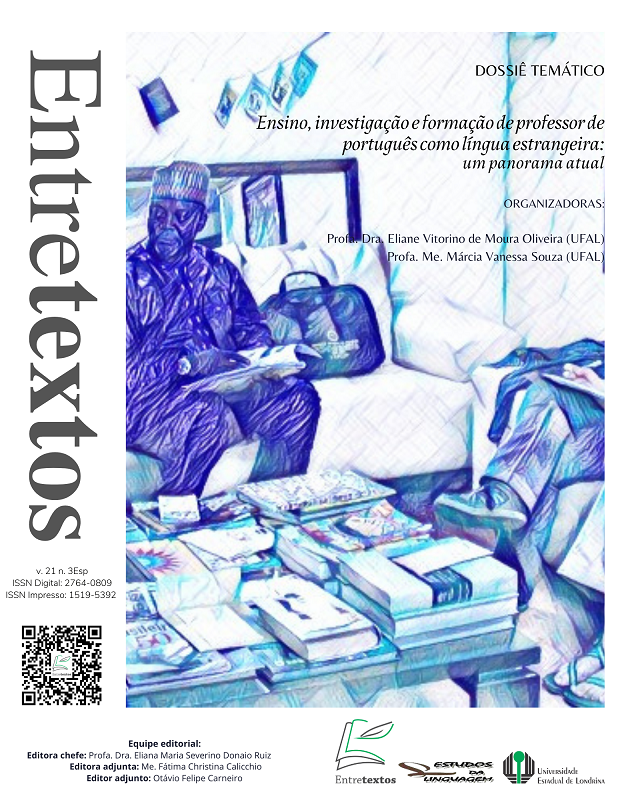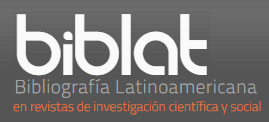Desviaciones de colocación en portugués como lengua extranjera
DOI:
https://doi.org/10.5433/1519-5392.2021v21n3Esp.p218Palabras clave:
Colocaciones, Interlengua, Portugués como Lengua ExtranjeraResumen
Este articulo tiene como objetivo discutir las desviaciones de colocación que se evidencian en las producciones textuales en portugués como lengua extranjera (en adelante PLE), como una forma de revelar las hipótesis planteadas por los estudiantes sobre el funcionamiento de la lengua portuguesa. Nuestras referencias teóricas incluyen las colocaciones, en la perspectiva fraseológica, en Sinclair (1991), Lewis (2000, 2012) y Tagnin (2013), el concepto de competencia colocaciones de Lewis (2000) y Wu (2003), y los procesos de interlengua de Selinker (1974), Henderson (1985) y Tarone (2006). Nuestra metodología incluye cinco propuestas para producciones de texto, del género e-mail, sobre aspectos culturales brasileños, como la gastronomía y los atractivos turísticos. Los participantes, a su vez, son ocho norteamericanos que desarrollaron actividades para promover el idioma inglés en Brasil durante nueve meses en 2015. Se analizaron las producciones textuales de los participantes, se identificaron las ocurrencias de desviaciones de colocaciones y se clasificaron según sus niveles de competencia, es decir, B1/B2 and C1/C2. Los datos revelaron que las desviaciones están motivadas en su mayoría por los procesos de transferencia lingüística y mal uso de elementos verbales y nominales, y más recurrentes en los niveles más avanzados de competencia en PLE.
Descargas
Citas
BACHMAN, Lyle. Habilidad lingüística comunicativa. In: LLOBERA, Miquel. (org.). Competencia comunicativa: documentos básicos en la enseñanza de lenguas extranjeras. Madrid: Edelsa, 1995. p. 105-127.
BAHNS, Jens. Lexical collocations: a contrastive view. ELT Journal, Oxford, v. 11, p. 56-63, 1993.
BRITTO, Luiz Percival Leme. A sombra do caos: ensino de línguas x tradição gramatical. São Paulo: Mercado de Letras, 1997.
BUTLER-TAKANA, Paul. Fossilization: a chronic condition or is consciousness-raising the cure? 2000. 93p. Dissertation (Master's in Arts) - Faculty of Arts, University of Birmingham. Birmingham, 2000.
CANALE, Michael. De la competencia comunicativa a la pedagogía comunicativa del lenguaje. In: LLOBERA, Miquel. (org.). Competencia comunicativa: documentos básicos en la enseñanza de lenguas extranjeras. Madrid: Edelsa, 1995. p. 63-81.
CARTER, Ronald. Vocabulary: applied linguistic perspectives. London: Routledge, 1987.
CONSELHO EUROPEU. Quadro Europeu Comum de Referência para as línguas: aprendizagem, ensino e avaliação. Lisboa: Edições ASA, 2001.
CORDER, Stephen Pit. Idiosyncratic dialects and error analysis. In: RICHARDS, James Clifton (org.). Error Analysis: Perspectives on Second Language Acquisition. London: Longman, 1974a. p. 158-171.
CORDER, Stephen Pit. The significance of Learners' Errors. In: RICHARDS, James Clifton (org.). Error analysis: perspectives on second language acquisition. London: Longman, 1974b. p. 19-27.
FIRTH, May B. Interlanguage theory: implications for the classroom. McGill Journal of Education, Montréal, v. 13, n. 2, p. 155-165, 1978.
FILLMORE, Charles J. Innocence: a second idealization for linguistics. Proceedings of the Berkeley Linguistics Society, Berkeley, v. 5, p. 63-76, 1979.
GASS, Susan M.; SELINKER, Larry. Second Language Acquisition: an introductory course. New Jersey: Lawrence Erlbaum, 1994.
GOMES, Marcela de Lima. As noções do termo erro para os estudos linguísticos e suas implicações ao ensino de língua portuguesa. 2016. 117p. Dissertação (Mestrado em Educação) - Instituto de Ciências da Educação, Universidade Federal do Oeste do Paraná. Paraná, 2016.
HENDERSON, Michael M. T. The notion of interlanguage. Journal of Modern Language Learning, Kansas, v. 21, p. 23-27, 1985.
HUNDT, Christine. Construções de verbo + substantivo: estrutura, semântica e posição dentro da fraseologia. Verbo e estruturas frásicas. Rev. Fac. de Letras - Línguas e Literaturas, Porto, p. 267-275, 1994.
HYMES, Dell Hathaway. On communicative competence. In: PRIDE, J. B.; HOLMES, J. (org.). Sociolinguistics: selected readings. Harmondsworth: Penguin, 1972. p. 269-293.
JUNIOR, Valdson José Santana; PINTO, Marie Jolly Nascimento; SANTANA, Robson Ferreira. Erro(s): Entre o desvio e a norma. V Colóquio Internacional "Educação e Contemporaneidade". São Cristóvão, p. 1-16, 2011.
LEWIS, Michael. Teaching collocations: further developments in the lexical approach. Hove: Language Teaching Publications, 2000.
LEWIS, Michael. The lexical approach: state of ELT and a way forward. 4th ed. London: Language Teaching Publications, 2012.
LLOBERA, Miquel. Una perspectiva sobre la competencia comunicativa y la didáctica de las lenguas extranjeras. In: LLOBERA, Miquel (org.). Competencia comunicativa: documentos básicos en la enseñanza de lenguas extranjeras. Madrid: Edelsa, 1995, p. 5-26.
MAIA, Francisca Paula Soares. O "erro" linguístico a partir de uma perspectiva sociolinguística laboviana. In: V CIEL - CICLO DE ESTUDOS EM LINGUAGEM. Estudos da Linguagem e Formação Docente: desafios contemporâneos. UEPG - Ponta Grossa, Paraná, 28 a 30 de abril, 2009.
O'DELL, Felicity; McCARTHY, Michael. English collocations in use, advanced: how words work together for fluent and natural English. Cambridge: Cambridge University Press, 2008.
SAVIGNON, J. Sandra. Communicative Competence: Theoretical and Classroom Practice. Reading: Addison-Wesley Publishing, 1983.
SELINKER, Larry. Interlanguage. In: RICHARDS, James Clifton (org.). Error analysis: perspectives on second language acquisition. London: Longman, 1974. p. 31-54.
SILVA NETTO, José William. Desenvolvimento da competência colocacional na produção escrita dos assistentes de professores de inglês em universidades brasileiras. 2016. Dissertação (Mestrado em Linguística) - Universidade Federal do Ceará, Centro de Humanidades, Fortaleza, 2016.
SINCLAIR, John. Collocation. Corpus, concordance, collocation. Oxford: Oxford University Press, 1991.
TAGNIN, Stella E. O. O jeito que a gente diz: combinações consagradas em inglês e português. São Paulo: Disal, 2013.
TARONE, Elaine. Interlanguage. Amsterdam: Elsevier, 2006.
WU, Wen-shuenn. A quantitative study of university students' collocational competence in an ESP context. ESP Malaysia, Malaysia, v. 9, p. 95-119, 2003.
Descargas
Publicado
Cómo citar
Número
Sección
Licencia
Derechos de autor 2021 Entretextos

Esta obra está bajo una licencia internacional Creative Commons Atribución 4.0.
Entretextos adota a Licença Creative Commons Attribution 4.0 International, portanto, os direitos autorais relativos aos artigos publicados são do/s autor/es.
Sob essa licença é possível: Compartilhar - copiar e redistribuir o material em qualquer suporte ou formato. Adaptar - remixar, transformar, e criar a partir do material, atribuindo o devido crédito e prover um link para a licença e indicar se mudanças foram feitas.
























